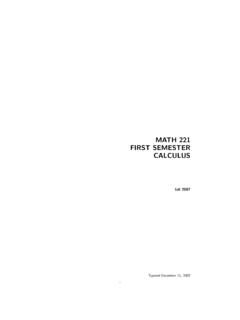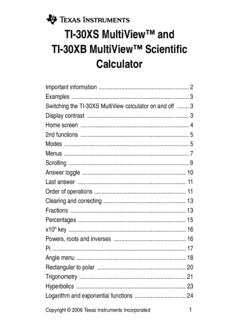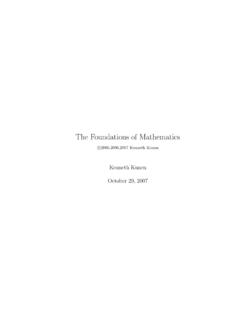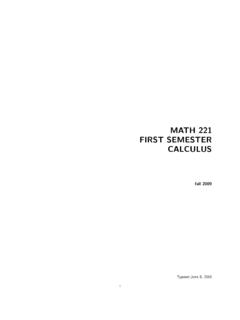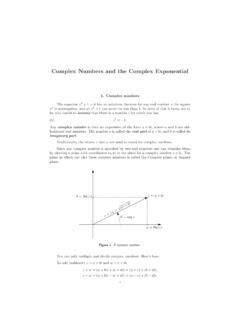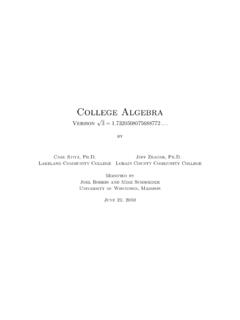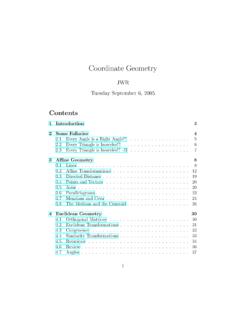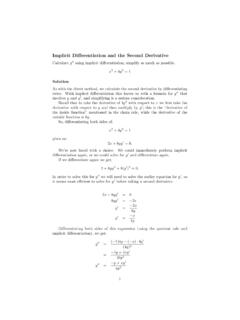Transcription of 1 Basics of Series and Complex Numbers
1 C FW Math 321, 2012/12/11 Elements of Complex Calculus 1 Basics of Series and Complex Numbers Algebra of Complex Numbers A Complex number z = x + iy is composed of a real part <(z) = x and an imaginary part =(z) = y, both of which are real Numbers , x, y R. Complex Numbers can be defined as pairs of real Numbers (x, y) with special manipulation rules. That's how Complex Numbers are defined in Fortran or C. We can map Complex Numbers to the plane R2 with the real part as the x axis and the imaginary part as the y-axis. We refer to that mapping as the Complex plane. This is a very useful visualization. The form x + iy is convenient with the special symbol i standing as the imaginary unit defined such that i2 = 1.
2 With that form and that special i2 = 1 rule, Complex Numbers can be manipulated like regular real Numbers . y z = x + iy |z|. x z = x i y Addition/subtraction: z1 + z2 = (x1 + iy1 ) + (x2 + iy2 ) = (x1 + x2 ) + i(y1 + y2 ). (1). This is identical to vector addition for the 2D vectors (x1 , y1 ) and (x2 , y2 ). Multiplication: z1 z2 = (x1 + iy1 )(x2 + iy2 ) = (x1 x2 y1 y2 ) + i(x1 y2 + x2 y1 ). (2). Complex conjugate: z = x iy (3). An overbar z or a star z denotes the Complex conjugate of z, which is same as z but with the sign of the imaginary part flipped. It is readily verified that the Complex conjugate of a sum is the sum of the conjugates: (z1 + z2 ) = z1 + z2 , and the Complex conjugate of a product is the product of the conjugates (z1 z2 ) = z1 z2 (show that as an exercise).
3 Modulus (or Norm) p |z| = zz = x2 + y 2 , (4). This modulus is equivalent to the euclidean norm of the 2D vector (x, y), hence it obviously satisfy the triangle inequality |z1 + z2 | |z1 | + |z2 |. However we can verify that |z1 z2 | = |z1 | |z2 |. Division: z1 z2 .. z1 (x1 + iy1 )(x2 iy2 ) x1 x2 + y1 y2 x2 y1 x1 y2. = = = +i . (5). z2 z2 z2 x22 + y22 x22 + y22 x22 + y22. All the usual algebraic formula apply, for instance (z + a)2 = z 2 + 2za + a2 and more generally the binomial formula (defining 0! = 1). n n n X n X n! (z + a) = z k an k = z k an k . (6). k k!(n k)! k=0 k=0. c F. Waleffe, Math 321 Notes, UW 2012/12/11 2.
4 Exercises: 1. Prove that (z1 + z2 ) = z1 + z2 , (z1 z2 ) = z1 z2 and |z1 z2 | = |z1 ||z2 |. 2. Calculate (1 + i)/(2 + i3). 3. Show that the final formula for division follows from the definition of multiplication (as it should): if z = z1 /z2 then z1 = zz2 , solve for <(z) and =(z). Limits and derivatives The modulus allows the definition of distance and limit. The distance between two Complex Numbers z and a is the modulus of their difference |z a|. A Complex number z tends to a Complex number a if |z a| 0, where |z a| is the euclidean distance between the Complex Numbers z and a in the Complex plane. A function f (z) is continuous at a if limz a f (z) = f (a).
5 These concepts allow the definition of derivatives and Series . The derivative of a function f (z) at z is df (z) f (z + a) f (z). = lim (7). dz a 0 a where a is a Complex number and a 0 means |a| 0. This limit must be the same no matter how a 0. We can use the binomial formula (6) as done in Calc I to deduce that dz n = nz n 1 (8). dz for any integer n = 0, 1, 2, .., and we can define the anti-derivative of z n as z n+1 /(n + 1) + C for all integer n 6= 1. All the usual rules of differentiation: product rule, quotient rule, chain rule,.. , still apply for Complex differentiation and we will not bother to prove those here, the proofs are just like in Calc I.
6 So there is nothing special about Complex derivatives , or is there? Consider the function f (z) =. <(z) = x, the real part of z. What is its derivative? Hmm.. , none of the rules of differentiation help us here, so let's go back to first principles: d<(z) <(z + a) <(z) <(a). = lim = lim =?! (9). dz a 0 a a 0 a What is that limit? If a is real, then a = <(a) so the limit is 1, but if a is imaginary then <(a) = 0. and the limit is 0. So there is no limit that holds for all a 0. The limit depends on how a 0, and we cannot define the z-derivative of <(z). <(z) is continuous everywhere, but nowhere z-differentiable! Exercises: 1.
7 Prove formula (8) from the limit definition of the derivative [Hint: use the binomial formula]. 2. Prove that (8) also applies to negative integer powers z n = 1/z n from the limit definition of the derivative. c F. Waleffe, Math 321 Notes, UW 2012/12/11 3. Geometric sums and Series For any Complex number q 6= 1, the geometric sum 1 q n+1. 1 + q + q2 + + qn = . (10). 1 q To prove this, let Sn = 1 + q + + q n and note that qSn = Sn + q n+1 1, then solve that for Sn . The geometric Series is the limit of the sum as n . It follows from (10), that the geometric Series converges to 1/(1 q) if |q| < 1, and diverges if |q| > 1.
8 X 1. qn = 1 + q + q2 + = , iff |q| < 1. (11). 1 q n=0. Note that we have two different functions of q: (1) the Series n P. n=0 q which only exists when |q| < 1, (2) the function 1/(1 q) which is defined and smooth everywhere except at q = 1. These two expressions, the geometric Series and the function 1/(1 q) are identical in the disk |q| < 1, but they are not at all identical outside of that disk since the Series does not make any sense ( it diverges) outside of it. What happens on the unit circle |q| = 1? (consider for example q = 1, q = 1, q = i, .. ). =(q). diverges |q| = 1. <(q). converges Exercises: 1. Derive formula (10) and absorb the idea of the proof.
9 What is Sn when q = 1? 2. Calculate q N + q N +2 + q N +4 + q N +6 + .. with |q| < 1. Ratio test The geometric Series leads to a useful test for convergence of the general Series . X. an = a0 + a1 + a2 + (12). n=0. We can make sense of this Series again as the limit of the partial sums Sn = a0 + a1 + + an as n . Any one of these finite partial sums exists but the infinite sum does not necessarily converge. Example: take an = 1 n, then Sn = n + 1 and Sn as n . A necessary condition for convergence is that an 0 as n as you learned in Math 222 and can explain why, but that is not sufficient. A sufficient condition for convergence is obtained by c F.
10 Waleffe, Math 321 Notes, UW 2012/12/11 4. comparison to a geometric Series . This leads to the Ratio Test: the Series (12) converges if |an+1 |. lim =L<1 (13). n |an |. Why does the ratio test work? If L < 1, then pick any q such that L < q < 1 and one can find a (sufficiently large) N such that |an+1 |/|an | < q for all n N so we can write . |aN +1 | |aN +2 | |aN +1 |. |aN | + |aN +1 | + |aN +2 | + |aN +3 | + = |aN | 1 + + + . |aN | |aN +1 | |aN |. (14). 2. |aN |. < |aN | 1 + q + q + = < . 1 q If L > 1, then we can reverse the proof ( pick q with 1 < q < L and N such that |an+1 |/|an | > q n N ) to show that the Series diverges.
